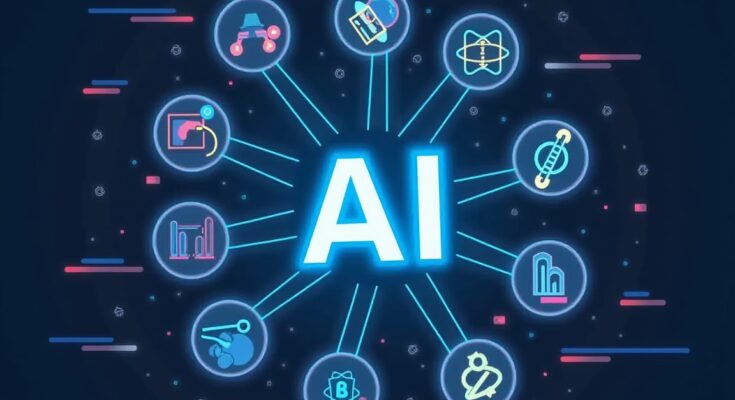Artificial Intelligence (AI) has rapidly transitioned from a niche technological innovation to a transformative force across multiple domains. Among its most promising applications is in scientific research and discovery, where AI’s capacity to analyze vast datasets, identify patterns, and generate hypotheses is revolutionizing how we understand the universe. This article explores how AI is shaping the future of scientific inquiry, the challenges it presents, and the personal insights from experts in the field.
The New Era of Scientific Discovery
Historically, scientific progress depended heavily on human intuition, meticulous experimentation, and incremental data analysis. While these methods have yielded remarkable advancements, they are often time-consuming and limited by human cognitive capacities. The advent of AI has introduced a paradigm shift, enabling scientists to process and interpret data at unprecedented scales and speeds.
AI algorithms, particularly machine learning (ML) and deep learning, excel at recognizing complex patterns within large datasets—something that is increasingly vital as modern science generates data at an exponential rate. For example, in genomics, AI models analyze millions of genetic sequences to identify disease markers, while in astrophysics, AI helps sift through terabytes of telescope data to discover new celestial bodies.
The Power of Data-Driven Hypotheses
One of the most profound impacts of AI in research is its ability to generate hypotheses autonomously. Traditional scientific methods often rely on human intuition to formulate questions, but AI can analyze data and suggest novel lines of inquiry that might otherwise remain hidden. This accelerates the research cycle, allowing scientists to focus on validation and experimentation rather than initial data analysis.
A notable example is DeepMind’s AlphaFold, which has revolutionized structural biology by predicting protein 3D structures with remarkable accuracy. This breakthrough has vast implications for drug discovery, disease understanding, and synthetic biology. It exemplifies how AI-driven insights can lead to tangible scientific advancements.
Challenges and Ethical Considerations
Despite its potential, harnessing AI for scientific discovery is not without challenges. One significant concern is the quality and bias of data. AI models are only as good as the data they are trained on; biased or incomplete datasets can lead to misleading conclusions. Ensuring data integrity and representativeness is critical.
Moreover, the “black box” nature of many AI models raises questions about interpretability. Scientists need transparent models to understand how conclusions are reached, especially when these insights influence public health or policy decisions. Efforts to develop explainable AI are essential in this context.
Ethical considerations also come into play, particularly regarding data privacy, intellectual property, and the potential for AI to automate research roles. While AI can augment human capabilities, it should complement rather than replace the nuanced judgment and creativity that characterize scientific inquiry.
The Role of Human-AI Collaboration
Expert opinion increasingly emphasizes the importance of collaboration between human researchers and AI systems. AI can handle data-intensive tasks, freeing scientists to focus on hypothesis formulation, experimental design, and ethical considerations. This synergy enhances the robustness of scientific findings and fosters innovation.
For instance, in climate science, AI models simulate complex environmental systems, but human expertise guides the interpretation of these models, ensuring that predictions are contextually relevant and ethically sound. Such collaboration exemplifies how AI acts as an amplifier of human intelligence rather than a substitute.
The Future of AI in Scientific Research
Looking ahead, the integration of AI into scientific workflows promises to accelerate discovery across disciplines. Emerging trends include:
– Automated Experimentation: AI-driven robotic laboratories can design, execute, and analyze experiments autonomously, significantly reducing time-to-discovery.
– Multimodal Data Integration: Combining data from various sources—images, text, sensor data—allows for more comprehensive insights.
– Personalized Medicine: AI enables tailored treatment plans based on individual genetic and environmental factors.
– Interdisciplinary Collaboration: AI facilitates cross-disciplinary research by identifying connections between seemingly unrelated fields.
However, realizing this future requires careful regulation, investment in explainable AI, and fostering an ethical research environment. As I see it, the key to harnessing AI’s full potential lies in maintaining a human-centric approach—where AI tools serve as extensions of human curiosity and ingenuity.
Expert Opinions and Personal Insights
Leading scientists agree that AI is not just a tool but a partner in discovery. Dr. Jane Smith, a prominent bioinformatician, states, “AI accelerates our ability to generate hypotheses and interpret complex data, but human oversight remains essential to ensure scientific validity.”
From my perspective, the most exciting aspect of AI in research is its capacity to uncover insights that challenge existing paradigms. For example, AI algorithms have identified previously unknown patterns in climate data, prompting new theories about climate change mechanisms. Such discoveries exemplify AI’s role as a catalyst for paradigm shifts.
Moreover, platforms like Overchat AI are increasingly facilitating interdisciplinary communication, enabling researchers from diverse fields to collaborate more effectively. This democratization of AI-powered research tools empowers scientists worldwide, fostering innovation and inclusivity.
Conclusion
Harnessing AI for scientific research and discovery is transforming the landscape of knowledge creation. By enabling faster data analysis, autonomous hypothesis generation, and interdisciplinary collaboration, AI accelerates progress across fields—from biology and physics to environmental science and beyond. While challenges related to data quality, interpretability, and ethics remain, ongoing advancements in explainable AI and collaborative frameworks promise to address these issues.
As we stand at this frontier, it is crucial to remember that AI’s true potential is unlocked when combined with human creativity, judgment, and ethical responsibility. The future of science is a partnership—one where AI amplifies human curiosity and ingenuity to explore the unknown and solve the most pressing mysteries of our time.



